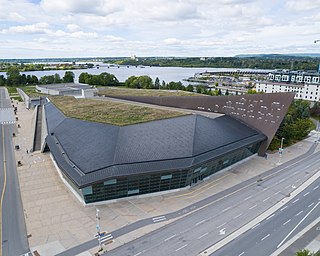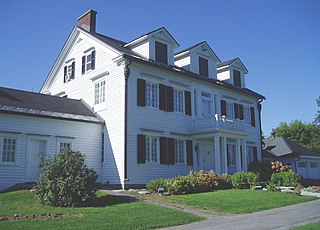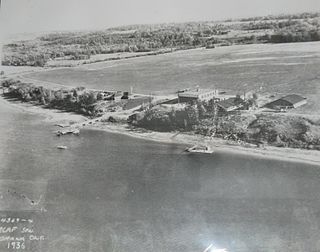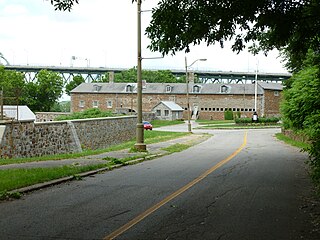
The Canadian War Museum (CWM) is a national museum on the country's military history in Ottawa, Ontario, Canada. The museum serves as both an educational facility on Canadian military history and a place of remembrance. The 40,860 square metres (439,800 sq ft) museum building is situated south of the Ottawa River in LeBreton Flats. The museum houses a number of exhibitions and memorials, in addition to a cafeteria, theatre, curatorial and conservation spaces, as well as storage space. The building also houses the Military History Research Centre, the museum's library and archives.

Walter Seymour Allward was a Canadian monumental sculptor best known for the Canadian National Vimy Memorial. Featuring expressive classical figures within modern compositions, Allward's monuments evoke themes of memory, sacrifice, and redemption. He has been widely praised for his "original sense of spatial composition, his mastery of the classical form and his brilliant craftsmanship".

The Tomb of the Unknown Soldier is a tomb situated before the National War Memorial in Confederation Square, Ottawa, Ontario. The tomb is dedicated to Canadian service members, and holds the remains of an unidentified Canadian soldier who died in France during the First World War; selected from a Commonwealth War Grave near Vimy, in the vicinity where the Battle of Vimy Ridge took place.
Canadian Forces Station Debert was a Canadian Forces station located in Debert, Nova Scotia. It was most recently used during the Cold War as a communications facility and was home to a "Regional Emergency Government Headquarters" (REGH) complex, more commonly known by their nickname "Diefenbunker."

The Diefenbunker, formerly known by its military designation, Canadian Forces Station Carp (CFS Carp), is a large underground four-storey reinforced concrete bunker and nuclear fallout shelter located in the rural area of Carp, Ontario approximately 30 km (19 mi) west of downtown Ottawa. Between 1957 and 1961, during the Cold War the Government of Canada led by then Prime Minister John Diefenbaker authorized the Diefenbunker to be designed and built as the Central Emergency Government Headquarters (CEGHQ Carp) in an attempt to ensure the continuity of government subsequent to a nuclear weapons attack by the Soviet Union. In 1994, CFS Carp was decommissioned and closed.

The Senate of Canada Building is a government building and former railway station that serves as the temporary seat of the Senate of Canada. Located at 2 Rideau Street in downtown Ottawa, it was known as Ottawa Union Station and served as the city's central railway station from 1912 until 1966. From 1966 to 2018, it was operated by the Government of Canada as the Government Conference Centre. The building currently includes a temporary Senate chamber, as well as some Senate offices and committee rooms.

The current Ottawa City Hall is the city hall of Ottawa, Ontario, Canada. The downtown complex consists of two connected buildings: a modern wing located on Laurier Avenue and a 19th-century heritage wing located on Elgin Street. Although City Hall has frontage on two major streets, the main entrance is on Laurier Avenue, and the municipal address is 110 Laurier Avenue West.

The Justice Annex was a building just east of the Supreme Court of Canada and west of Parliament Hill in Ottawa, Ontario, Canada. Built in 1942–3, it was the last surviving representative of many similar temporary buildings erected during the Second World War to house the rapidly growing number of government employees. This building was built to house Royal Canadian Mounted Police (RCMP) officers. It later became the headquarters of C.D. Howe's Department of Munitions and Supply. After the war it was given to the Justice Department and named the Justice Annex.

The Billings Estate National Historic Site is a heritage museum in Ottawa, Ontario, Canada. It is located at 2100 Cabot St. in the former home of one of the region's earliest settlers. The oldest wood-framed house in Ottawa was built in 1827-9 by Massachusetts-born Braddish Billings. It became the home for the following four generations of the Billings family. It is Ottawa's oldest surviving house, though the Bytown Museum building is older. Billings had moved to the area in 1812, and was the first settler in Gloucester Township.

Queen's Quay Terminal is a condominium apartment, office and retail complex in the Harbourfront neighbourhood in Toronto, Ontario, Canada. It was originally built in 1927 as a marine terminal with office, warehouse and cold-storage facilities. When shipping to Toronto declined in the 1960s and 1970s, the building was bought by the Government of Canada to be repurposed along with a section of the industrial waterfront. The Terminal Building itself was rebuilt in the 1980s with the addition of four floors of residential above the original facility, which was converted into retail and office uses. The cold storage wing was demolished and its plant building became The Power Plant gallery and Harbourfront Centre Theatre.

Canadian Forces Base Rockcliffe is a former Canadian Forces Base located in the eastern part of Ottawa, Ontario, now used for Ottawa/Rockcliffe Airport and the Canada Aviation and Space Museum.

The Saint Helen Island Fort, a historic site on Saint Helen's Island in the city of Montreal, Quebec, was constructed in the early 1820s as an arsenal in the defensive chain of forts built to protect Canada from a threat of American invasion. Although not heavily fortified, it served an important purpose as the central artillery depot for all forts west, and in the Richelieu River Valley, known as the Valley of the Forts. These included Fort Henry and Fort Lennox. The red stone used to build the Fort is a breccia quarried on the island, which is situated in the St. Lawrence River between the island of Montreal and the south shore.

Northern Ohio Railway Museum is a railroad museum located near Chippewa Lake, Ohio, United States. The museum is a non-profit, educational organization. It was established in 1965, granted 501(c)(3) status by the Internal Revenue Service in 1966 and incorporated under the laws of the State of Ohio in 1976. The membership is approximately 180 electric railway devotees who reside throughout the United States and Canada, with the majority clustered in northeastern Ohio.

The United States Army Heritage and Education Center (USAHEC), at Carlisle Barracks, Pennsylvania, is the U.S. Army's primary historical research facility. Formed in 1999 and reorganized in 2013, the center consists of the Military History Institute (MHI), the Army Heritage Museum (AHM), the Historical Services Division (HSD), Visitor and Education Services (VES), the U.S. Army War College Library, and Collections Management (CM). The U.S. Army Heritage and Education Center is part of the United States Army War College, but has its own 56-acre (230,000 m2) campus.

The Paul E. Garber Preservation, Restoration, and Storage Facility, also known colloquially as "Silver Hill", is a storage and former conservation and restoration facility of the Smithsonian National Air and Space Museum, located in Suitland, Maryland, United States. Located adjacent to the Museum Support Center – a facility that serves the same purpose for other Smithsonian museums – the Paul E. Garber Facility was once the main artifact restoration facility of the National Air and Space Museum. The museum still stores aircraft and other artifacts at the Paul E. Garber Facility, but most storage and restoration functions have relocated to the Mary Baker Engen Restoration Hangar at the Steven F. Udvar-Hazy Center in Chantilly, Virginia. The facility is not open to the public.
The Plaza Bridge in Ottawa, Ontario, Canada, is an automotive and pedestrian bridge that crosses the Rideau Canal just south of the Ottawa locks. It joins Wellington Street and Elgin Street in the Downtown core to the west with Rideau Street to the east. The Chateau Laurier abuts the bridge at the east end, while Parliament Hill is just beyond the west end. It is the northernmost bridge over the canal, just north of the Mackenzie King Bridge.
The Nepean Museum is a museum in Ottawa, Ontario, Canada. It is a community-focused museum that preserves, makes accessible and communicates the former municipality of Nepean's history. Artifacts related to Nepean, from its beginnings to the 20th century, are restored and displayed in the museum galleries and grounds. The museum has an open concept exhibit area of approximately 2000sq ft. The museum collects, preserves, researches, exhibits and interprets the works of man and nature in Nepean. Its address is 16 Rowley Avenue, Ottawa, Ontario, Canada.
Ottawa Electric Railway Company was a streetcar public transit system in the city of Ottawa, Canada, part of the electric railway streetcars that operated between 1891 and 1959. Ottawa once had tracks through downtown on Rideau Street, Sparks Street and others, and extended outside of the downtown core to provide services that helped form communities such as Westboro, Old Ottawa South and The Glebe. Prior to this, starting in 1866, public transportation was provided by Ottawa City Passenger Railway Company, a horse-drawn tram service. The O.E.R. was taken over by the Ottawa Transportation Commission in 1948, which was itself succeeded by OC Transpo in 1973.
Vimy is a commune in the Pas-de-Calais department in the Nord-Pas-de-Calais region of France

The Treloar Resource Centre, also known as the Treloar Centre and Treloar Technology Centre, is the Australian War Memorial's (AWM's) storage and conservation facility. It is located in the industrial suburb of Mitchell, Australian Capital Territory. The AWM describes the Treloar Resource Centre as "the Memorial's conservation facility and store for large objects of military technology, including aircraft, vehicles, boats, missiles and guns".















